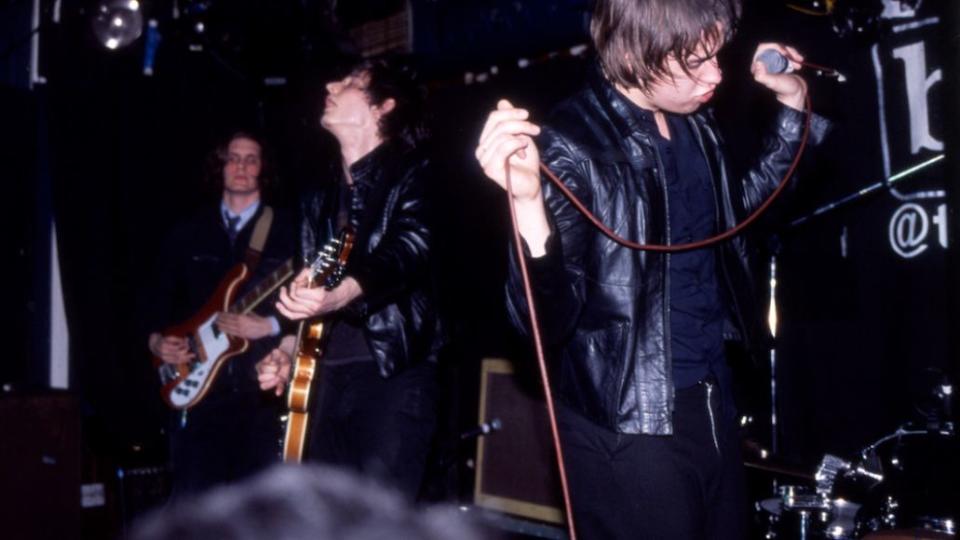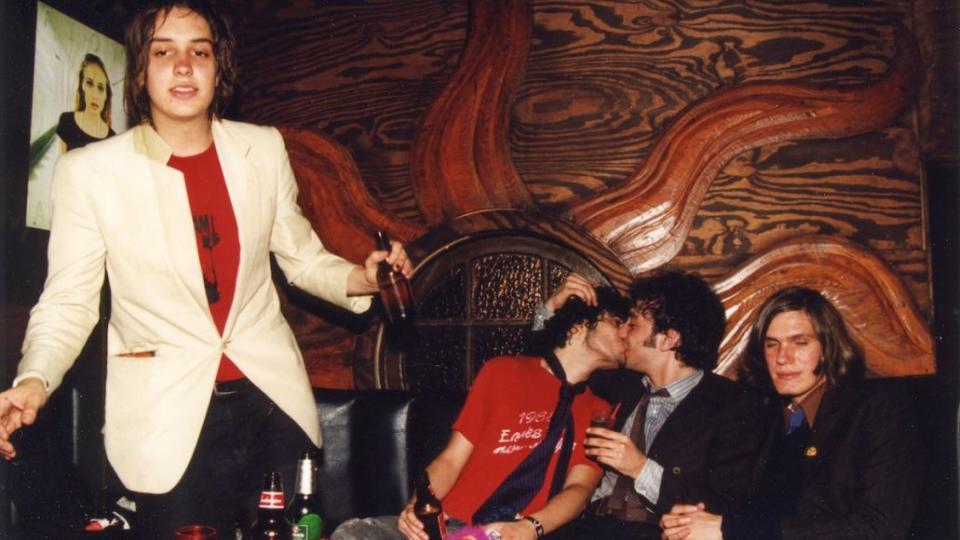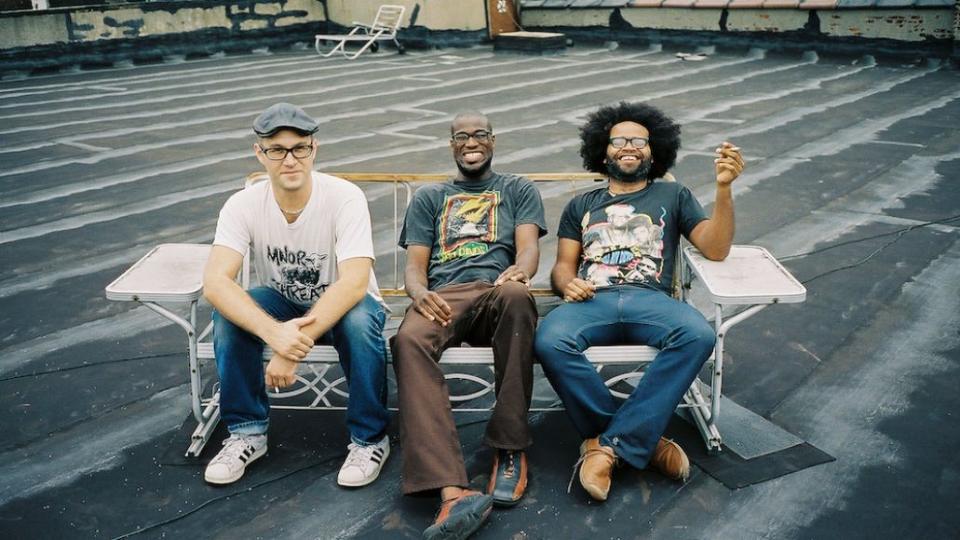5 Takeaways From the Meet Me in the Bathroom Documentary
- Oops!Something went wrong.Please try again later.
- Oops!Something went wrong.Please try again later.
- Oops!Something went wrong.Please try again later.
The post 5 Takeaways From the Meet Me in the Bathroom Documentary appeared first on Consequence.
It feels strange to think that we’re 20 years removed from one of the most vibrant music scenes in New York City’s history — but in Meet Me in the Bathroom, the documentary adapted from Lizzy Goodman’s 2017 oral history, all it takes is one look at Julian Casablancas‘ 19-year-old face to realize how much things have changed.
At the premiere event in New York City for Meet Me in the Bathroom on Sunday night (October 30th), hundreds of indie lovers packed into Webster Hall to relish in the nostalgia of the city’s undeniable musical output at the dawn of the millennium.
From start to finish, the Meet Me in the Bathroom adaptation, directed by Shut Up and Play The Hits filmmakers Will Lovelace and Dylan Southern, is certainly the time capsule it promises to be, and it’s filled with fascinating live footage and interview clips from The Strokes, Yeah Yeah Yeahs, Interpol, LCD Soundsystem, TV on the Radio, The Moldy Peaches, and more. If members of the scene had ever boasted that “you had to be there,” well, the Meet Me in the Bathroom doc is certainly the closest we can get.
To celebrate the documentary’s NYC premiere, The Moldy Peaches’ Adam Green made an appearance to perform and offer his insights in a discussion with author Lizzy Goodman and the film’s directors. In addition to a performance from WAH Together (which features members of LCD Soundsystem and The Rapture), the premiere event was a successful converging of 2000s nostalgia with the necessary acknowledgment of today’s wildly different rock scene.
The documentary depicts major political and social changes, such as 9/11, the rise of Napster and pirated music, gentrification, and the war in Iraq as the attention on these young bands grew to seismic heights. But it also demonstrates the sheer amount of energy and enthusiasm that these shows boasted, and though the New York scene may never be what it was like in the late ’70s and early 2000s, the spirit will live on.
Read below for our five main takeaways from the Meet Me in the Bathroom documentary, and check out our full review here.
Everybody Wants to Be Famous
Perhaps the largest focal point of Meet Me in the Bathroom is Julian Casablancas and Karen O‘s sudden rise to fame. The documentary does a fantastic job of juxtaposing footage the early bombastic days of The Strokes and The Yeah Yeah Yeahs with the more chaotic, MTV-aided era that would follow. It’s fascinating to see their introverted energy be put to the test as they forged their iconic onstage personas, and it’s clear that the pressure took a toll on them both physically and mentally.
There’re a few moments in the latter half that hint at a full collapse of their respective bands. After Karen O suffered from a nasty stage fall in Australia, we hear her immediate thoughts as the accident occurred: “It’s over. We’re over,” she says, acknowledging the frailty of their sudden success. Meanwhile, The Strokes’ turbulent journey is highlighted by the unnerving presence of Ryan Adams, who Albert Hammond Jr. claims got him much deeper into heroin and drove him apart from Casablancas (Adams, however, alleges that the two were simply friends, and he never gave him heroin). But for Casablancas, it wasn’t really just about the drugs — it was about losing control of the band, and therefore losing the success that they had earned.

The Strokes, photo by Alessio Pizzicannella
Though they both survived the turbulence and continued forging the path for their respective bands, the documentary does a great job of displaying the intense pressure and scrutiny they faced, and the ensuing trauma that came with it. This is perhaps best explored with Karen O, who speaks candidly about her experience fronting a rock band as an Asian American woman. The blatant “lad culture” misogyny from the ’90s had bled over into the early 2000s, and it’s sad to reckon with the fact that Karen O wasn’t allowed much control over the band’s image (“Cool! Sexy! Drunk!” was printed on one of their first major magazine covers). Luckily, we’re given a great deal of footage and empowering reflections on Karen O’s impact, and the documentary does her journey a good amount of justice.
Dance Fever
Another illuminating tale highlighted in Meet Me in the Bathroom is James Murphy and Tim Goldsworthy’s creation of their DFA label and signing their first band, The Rapture. Both Murphy and The Rapture detail what was a grueling recording process when helming the band’s debut, Echoes — though they were aligned for the most part sonically, The Rapture’s Luke Jenner recalls being intimidated by Murphy’s perfectionism, and wondered why Murphy hadn’t just formed his own band. “I couldn’t bulldoze him,” says Jenner.
Eventually, they finished the album, but Murphy and Goldsworthy were unsuccessful in finding a distributor. The Rapture were touring and promoting their album with only a single song released at that point — “House of Jealous Lovers” — and they felt like they were running out of time (and steam). About a year later, and with hopes that they could finally release Echoes, The Rapture signed with a major label, which devastated Murphy. This separation wasn’t exactly personal, but it was one of the few catalysts for Murphy to begin his own project, LCD Soundsystem.

James Murphy, photo by Timothy Saccenti
It’s a treat to see the humble origins of DFA, and even more interesting to see that despite The Rapture’s air-tight sound, there was a lot more happening behind the scenes. But Murphy’s vision for dance music at the time was also wildly unique, and his enthusiasm for an almost utopian presentation of dance punk gave way to a significant explosion of the genre.
Everyone Is Offline
One of the aspects heavily highlighted in Meet Me in the Bathroom is community: these were spaces of collective joy and primal expression, initially popularized through word of mouth, early internet blogs, and DIY venues. These days, success is still granted by those metrics, but we have a wildly different way of connecting over our favorite bands. The fandom around the next big band or artist lives primarily on social media, and it’s becoming seemingly impossible for bands to break through without a significant social media presence.
It’s interesting to consider that The Strokes, the Yeah Yeah Yeahs, and Interpol went from inner city secrets to MTV starlets practically overnight; the speed at which a small band became well-known was faster than it had ever been. But today, there’s a much larger grey area that occupies that space. The rungs of the ladder have gotten wider, but the ladder has grown twice as tall, with labels demanding arbitrary milestones needed in streaming, ticket sales, and social media metrics in order to put an artist on the next rung.

The Strokes, photo by Piper Ferguson
It’s difficult to imagine a band in 2022 whose rise compares to that of The Strokes and their contemporaries, and who belong to a scene as visible and attractive as New York’s in the early 2000s. Even a band like Glass Animals — who’ve enjoyed moderate success from their first two albums throughout the last decade — only really broke through when “Heat Waves” went viral on TikTok in early 2021, nearly 10 years after their inception. Now, they’re boasting a record-breaking single and astounding success, but they lack the kind of iconography and fervor that characterized the bands from Meet Me in the Bathroom.
New York Cares
It’s not long into the documentary that we’re shown footage of the 9/11 terrorist attacks, and the filmmakers stress the impact this had on the city’s artists and musicians. There had never been a more urgent need for collective processing and mourning, and the city’s musicians banded together to provide cathartic spaces for the public to relish in. Meet Me in the Bathroom notes the correlation between 9/11’s devastating impact — physically and psychologically — to the island of Manhattan and the ensuing Brooklyn explosion that followed.
Tons of musicians and artists were trekking across the bridges to Williamsburg and settling in the neighborhood’s many abandoned warehouses and lofts. There were public shows in parking lots, brand new recording studios in renovated industrial buildings, and a sense of hope and excitement that bubbled up and exploded out into the rest of the world. It wasn’t all optimism — TV on the Radio was one of many bands who felt the impact of gentrification, and this segment of the documentary feels prescient and bittersweet.
20 years later, however, darkness descended once again on New York City, with COVID-19 devastating our communities and forcing New Yorkers to take care of each other in a way they hadn’t been urged to since 9/11. But as restrictions have lifted and hundreds have come flooding back into the city, the cultural landscape of New York is in a fraught place at the current moment. The gentrification of the early 2000s (among other factors) has created a significant housing bubble and displaced twice as many long-dwelling communities and artists; our music scenes are fractured, monopolized by two promoters and rendered inaccessible; pre-pandemic mainstays for smaller artists and musicians have closed their doors forever.
It’s worth wondering where the next “scene” will arise from, what seedy basement is currently hosting the next big band. But even with conditions stacked against the artists of New York, we can always rely on their ability to persevere, and create in search of the new and the novel.
Good Tunes
The best thing about Meet Me in the Bathroom is not the close view of artists in their early days; it’s the fact that the music that came from this scene — for the most part — still holds up. Witnessing footage of an early Interpol performance of Turn On the Bright Lights cut “Untitled” shows that the band’s success was anything but an accident, and the magic of those guitar parts still strike an emotional chord today. Karen O’s wildly expressive vocal performances are still capable of jolting you awake and holding your gaze; The Rapture’s free-wheeling spirit still begs you to dance and yell and cry.
One band that deserves a bit more recognition, however, is TV on the Radio. Though their widespread success arrived in the latter portion of the decade, they were a fundamental and important act in the Brooklyn scene at the time, and their dynamic art rock jams are still unique and arresting today.

TV On The Radio, photo by Ruvan Wijesooriya
And finally, the most apt musical placement arrives in the middle of the documentary where LCD Soundsystem’s first single, “Losing My Edge,” plays alongside its music video. It’s a great song in and of itself, but Murphy’s wistful and almost pathetic expression of aging within a vibrant, youthful scene becomes even more impactful in the context of the film. Meet Me in the Bathroom is a terrific display of forgotten youth, of a time where people were unbound and delighting in free expression, hedonism, and euphoria. But throughout the film is the undeniable fact that, like everything, it won’t last forever.
Meet Me in the Bathroom opens November 4th at the IFC Center in New York and the Los Feliz Theatre in Los Angeles, with one-night-only screenings taking place on November 8th in theaters nationwide. The doc will also stream on SHOWTIME® beginning November 25th.
5 Takeaways From the Meet Me in the Bathroom Documentary
Paolo Ragusa
Popular Posts

